Luminescence Properties of an Orthorhombic KLaF4 Phosphor Doped with Pr3+ Ions under Vacuum Ultraviolet and Visible Excitation
Abstract
:1. Introduction
- If E(4f5d) < E(1S0), only interconfigurational 4f5d → 4f transitions are observed;
- If E(4f5d) >> E(1S0), nonradiative relaxation between these two levels occurs, and only 4f → 4f transitions are observed;
- If E(4f5d) ≥ E(1S0), both 4f5d → 4f and 4f → 4f transitions take place.
2. Materials and Methods
3. Results and Discussion
3.1. Structure
3.2. Optical Properties
3.2.1. VUV Excitation
3.2.2. Visible Excitation
{20,809; 186} → {16,775; 4275} − 55 [cm−1]
{16,775; 0} → {9694; 6969} + 112 [cm−1]
3.2.3. Thermal Behavior of Luminescence
{21,352; 0} → {16,775; 4457} − 120 [cm−1].
4. Conclusions
Supplementary Materials
Author Contributions
Funding
Institutional Review Board Statement
Informed Consent Statement
Data Availability Statement
Acknowledgments
Conflicts of Interest
References
- Jang, H.S.; Im, W.B.; Lee, D.C.; Jeon, D.Y.; Kim, S.S. Enhancement of Red Spectral Emission Intensity of Y3Al5O12:Ce3+ Phosphor via Pr Co-Doping and Tb Substitution for the Application to White LEDs. J. Lumin. 2007, 126, 371–377. [Google Scholar] [CrossRef]
- Pawar, P.P.; Munishwar, S.R.; Gedam, R.S. Physical and Optical Properties of Dy3+/Pr3+ Co-Doped Lithium Borate Glasses for W-LED. J. Alloys Compd. 2016, 660, 347–355. [Google Scholar] [CrossRef]
- Dereń, P.J.; Pązik, R.; Stręk, W.; Boutinaud, P.; Mahiou, R. Synthesis and Spectroscopic Properties of CaTiO3 Nanocrystals Doped with Pr3+ Ions. J. Alloys Compd. 2008, 451, 595–599. [Google Scholar] [CrossRef]
- Gao, Y.; Huang, F.; Lin, H.; Zhou, J.; Xu, J.; Wang, Y. A Novel Optical Thermometry Strategy Based on Diverse Thermal Response from Two Intervalence Charge Transfer States. Adv. Funct. Mater. 2016, 26, 3139–3145. [Google Scholar] [CrossRef]
- Brites, C.D.S.; Fiaczyk, K.; Ramalho, J.F.C.B.; Sójka, M.; Carlos, L.D.; Zych, E. Widening the Temperature Range of Luminescent Thermometers through the Intra- and Interconfigurational Transitions of Pr3+. Adv. Opt. Mater. 2018, 6, 1701318. [Google Scholar] [CrossRef]
- Stefanska, J.; Marciniak, L. Single-Band Ratiometric Luminescent Thermometry Using Pr3+ Ions Emitting in Yellow and Red Spectral Ranges. Adv. Photonics Res. 2021, 2, 2100070. [Google Scholar] [CrossRef]
- Luo, Z.; Wu, D.; Xu, B.; Xu, H.; Cai, Z.; Peng, J.; Weng, J.; Xu, S.; Zhu, C.; Wang, F.; et al. Two-Dimensional Materi-al-Based Saturable Absorbers: Towards Compact Visible-Wavelength All-Fiber Pulsed Lasers. Nanoscale 2016, 8, 1066–1072. [Google Scholar] [CrossRef] [PubMed]
- Gün, T.; Metz, P.; Huber, G. Power Scaling of Laser Diode Pumped Pr3+:LiYF4 CW Lasers: Efficient Laser Operation at 522.6 nm, 545.9 nm, 607.2 nm, and 639.5 nm. Opt. Lett. 2011, 36, 1002–1004. [Google Scholar] [CrossRef]
- Mazurak, Z.; Bodył, S.; Lisiecki, R.; Gabryś-Pisarska, J.; Czaja, M. Optical Properties of Pr3+, Sm3+ and Er3+ Doped P2O5–CaO–SrO–BaO Phosphate Glass. Opt. Mater. 2010, 32, 547–553. [Google Scholar] [CrossRef]
- Klimesz, B.; Dominiak-Dzik, G.; Lisiecki, R.; Ryba-Romanowski, W. Systematic Study of Spectroscopic Properties and Thermal Stability of Lead Germanate Glass Doped with Rare-Earth Ions. J. Non-Cryst. Solids 2008, 354, 515–520. [Google Scholar] [CrossRef]
- Abdukayum, A.; Chen, J.-T.; Zhao, Q.; Yan, X.-P. Functional Near Infrared-Emitting Cr3+/Pr3+ Co-Doped Zinc Gallogermanate Persistent Luminescent Nanoparticles with Superlong Afterglow for in Vivo Targeted Bioimag-ing. J. Am. Chem. Soc. 2013, 135, 14125–14133. [Google Scholar] [CrossRef]
- Dorenbos, P. The 5d Level Positions of the Trivalent Lanthanides in Inorganic Compounds. J. Lumin. 2000, 91, 155–176. [Google Scholar] [CrossRef]
- Srivastava, A.M. Aspects of Pr3+ Luminescence in Solids. J. Lumin. 2016, 169, 445–449. [Google Scholar] [CrossRef]
- Dorenbos, P. 5d-Level Energies of Ce 3+ and the Crystalline Environment. I. Fluoride Compounds. Phys. Rev. B 2000, 62, 15640–15649. [Google Scholar] [CrossRef]
- Dorenbos, P. 5d-Level Energies of Ce3+ and the Crystalline Environment. II. Chloride, Bromide, and Iodide Compounds. Phys. Rev. B 2000, 62, 15650–15659. [Google Scholar] [CrossRef]
- Dorenbos, P. 5d-Level Energies of Ce3+ and the Crystalline Environment. III. Oxides Containing Ionic Complexes. Phys. Rev. B 2001, 64, 125117. [Google Scholar] [CrossRef]
- Dorenbos, P. 5d-Level Energies of Ce3+ and the Crystalline Environment. IV. Aluminates and “Simple” Oxides. J. Lumin. 2002, 99, 283–299. [Google Scholar] [CrossRef]
- Sommerdijk, J.L.; Bril, A.; de Jager, A.W. Two Photon Luminescence with Ultraviolet Excitation of Trivalent Praseodymium. J. Lumin. 1974, 8, 341–343. [Google Scholar] [CrossRef]
- Piper, W.W.; DeLuca, J.A.; Ham, F.S. Cascade Fluorescent Decay in Pr3+-Doped Fluorides: Achievement of a Quantum Yield Greater than Unity for Emission of Visible Light. J. Lumin. 1974, 8, 344–348. [Google Scholar] [CrossRef]
- Kück, S.; Sokólska, I.; Henke, M.; Döring, M.; Scheffler, T. Photon Cascade Emission in Pr3+-Doped Fluorides. J. Lumin. 2003, 102–103, 176–181. [Google Scholar] [CrossRef]
- Sommerdijk, J.L.; Bril, A.; De Jager, A.W. Luminescecne of Pr3+-Activated Fluorides. J. Lumin. 1974, 9, 288–296. [Google Scholar] [CrossRef]
- Sokólska, I.; Kück, S. Observation of Photon Cascade Emission in the Pr3+-Doped Perovskite KMgF3. Chem. Phys. 2001, 270, 355–362. [Google Scholar] [CrossRef]
- Shiran, N.; Neicheva, S.; Gektin, A.; Boyarintseva, Y.; Stryganyuk, G.; Shimamura, K.; Villora, E. Luminescence of Pr-Doped LiCaAlF6 and LiSrAlF6 Crystals. J. Lumin. 2009, 129, 1542–1545. [Google Scholar] [CrossRef]
- Rodnyi, P.A.; Dorenbos, P.; Stryganyuk, G.B.; Voloshinovskii, A.S.; Potapov, A.S.; van Eijk, C.W.E. Emission of Pr3+ in SrAl12O19 under Vacuum Ultraviolet Synchrotron Excitation. J. Phys. Condens. Matter 2003, 15, 719–729. [Google Scholar] [CrossRef]
- Srivastava, A.M.; Doughty, D.A.; Beers, W.W. Photon Cascade Luminescence of Pr3+ in LaMgB5O10. J. Electrochem. Soc. 1996, 143, 4113–4116. [Google Scholar] [CrossRef]
- Wang, D.; Huang, S.; You, F.; Qi, S.; Fu, Y.; Zhang, G.; Xu, J.; Huang, Y. Vacuum Ultraviolet Spectroscopic Properties of Pr3+ in MYF4 (M=Li, Na, and K) and LiLuF4. J. Lumin. 2007, 122–123, 450–452. [Google Scholar] [CrossRef]
- Ahmad, S.; Prakash, G.V.; Nagarajan, R. Hexagonally Ordered KLaF4 Host: Phase-Controlled Synthesis and Luminescence Studies. Inorg. Chem. 2012, 51, 12748–12754. [Google Scholar] [CrossRef] [PubMed]
- Liu, R.; Tu, D.; Liu, Y.; Zhu, H.; Li, R.; Zheng, W.; Ma, E.; Chen, X. Controlled Synthesis and Optical Spectroscopy of Lanthanide-Doped KLaF4 Nanocrystals. Nanoscale 2012, 4, 4485–4491. [Google Scholar] [CrossRef] [PubMed]
- Deo, I.S.; Gupta, M.; Prakash, G.V. Up- and Downconversion Dual-Mode Excitation Spectral Studies of Rare Earth Doped KLaF4 Nano Emitters for Biophotonic Applications. J. Phys. Chem. C 2023, 127, 24233–24241. [Google Scholar] [CrossRef]
- Gupta, M.; Deo, I.S.; Nagarajan, R.; Prakash, G.V. Highly Efficient Hexagonal-Phase Nd3+ Doped KLaF4 Nano-particles Colloidal Suspension for Liquid Lasers. Opt. Mater. 2022, 133, 113045. [Google Scholar] [CrossRef]
- Bajaj, R.; Gupta, M.; Nagarajan, R.; Rao, A.S.; Vijaya Prakash, G. Strong Structural Phase Sensitive Rare-Earth Photoluminescence Color Flips in KLaF4:RE3+ (RE3+ = Eu3+, Er3+/Yb3+) Nanocrystals. Dalton Trans. 2020, 49, 10058–10068. [Google Scholar] [CrossRef] [PubMed]
- Du, Y.-P.; Zhang, Y.-W.; Sun, L.-D.; Yan, C.-H. Optically Active Uniform Potassium and Lithium Rare Earth Fluoride Nanocrystals Derived from Metal Trifluroacetate Precursors. Dalton Trans. 2009, 8574–8581. [Google Scholar] [CrossRef] [PubMed]
- Das, S.; Amarnath Reddy, A.; Ahmad, S.; Nagarajan, R.; Vijaya Prakash, G. Synthesis and Optical Characterization of Strong Red Light Emitting KLaF4:Eu3+ Nanophosphors. Chem. Phys. Lett. 2011, 508, 117–120. [Google Scholar] [CrossRef]
- Brunton, G. The Crystal Structure of β-KCeF4. Acta Cryst. 1969, B25, 600–602. [Google Scholar] [CrossRef]
- Shannon, R.D. Revised Effective Ionic Radii and Systematic Studies of Interatomic Distances in Halides and Chalcogenides. Acta Cryst. 1976, 32, 751–767. [Google Scholar] [CrossRef]
- Prokop, K.A.; Guzik, M.; Guyot, Y.; Boulon, G.; Cybińska, J. Combining XRD and SEM Techniques with Site Selective Spectroscopy for Structural and Spectroscopic Studies of Nd3+-Doped LuPO4 Micro-Powders. Ceram. Int. 2020, 46, 26350–26360. [Google Scholar] [CrossRef]
- Dorenbos, P. The 4fn↔4fn−15d Transitions of the Trivalent Lanthanides in Halogenides and Chalcogenides. J. Lumin. 2000, 91, 91–106. [Google Scholar] [CrossRef]
- Kaminskii, A.A. Crystalline Lasers: Physical Processes and Operating Schemes; CRC Press, Inc.: Boca Raton, FL, USA, 1996. [Google Scholar]
- Kück, S.; Sokólska, I.; Henke, M.; Scheffler, T.; Osiac, E. Emission and Excitation Characteristics and Internal Quantum Efficiencies of Vacuum-Ultraviolet Excited Pr3+-Doped Fluoride Compounds. Phys. Rev. B 2005, 71, 165112. [Google Scholar] [CrossRef]
- de Jong, M.; Biner, D.; Krämer, K.W.; Barandiarán, Z.; Seijo, L.; Meijerink, A. New Insights in 4f125d1 Excited States of Tm2+ through Excited State Excitation Spectroscopy. J. Phys. Chem. Lett. 2016, 7, 2730–2734. [Google Scholar] [CrossRef]
- Mahlik, S.; Wiśniewski, K.; Grinberg, M.; Meltzer, R.S. Temperature and Pressure Dependence of the Luminescence of Eu2+-Doped Fluoride Crystals BaxSr1− xF2(x = 0, 0.3, 0.5, and 1): Experiment and Model. J. Phys. Condens. Matter 2009, 21, 245601. [Google Scholar] [CrossRef]
- Runowski, M.; Woźny, P.; Martín, I.R.; Lavín, V.; Lis, S. Praseodymium Doped YF3:Pr3+ Nanoparticles as Optical Thermometer Based on Luminescence Intensity Ratio (LIR)–Studies in Visible and NIR Range. J. Lumin. 2019, 214, 116571. [Google Scholar] [CrossRef]
- Zatryb, G.; Klak, M.M. On the Choice of Proper Average Lifetime Formula for an Ensemble of Emitters Showing Non-Single Exponential Photoluminescence Decay. J. Phys. Condens. Matter 2020, 32, 15902. [Google Scholar] [CrossRef]
- Judd, B.R. Optical Absorption Intensities of Rare-Earth Ions. Phys. Rev. 1962, 127, 750–761. [Google Scholar] [CrossRef]
- Ofelt, G.S. Intensities of Crystal Spectra of Rare-Earth Ions. J. Chem. Phys. 1962, 37, 511–520. [Google Scholar] [CrossRef]
- Carnall, W.T.; Fields, P.R.; Wybourne, B.G. Spectral Intensities of the Trivalent Lanthanides and Actinides in Solution. I. Pr3+, Nd3+, Er3+, Tm3+, and Yb3+. J. Chem. Phys. 1965, 42, 3797–3806. [Google Scholar] [CrossRef]
- Görller-Walrand, C.; Binnemans, K. Chapter 167 Spectral Intensities of f-f Transitions. In Handbook on the Physics and Chemistry of Rare Earths; Elsevier: Amsterdam, The Netherlands, 1998; Volume 25, pp. 101–264. [Google Scholar]
- Peacock, R.D. The Intensities of Lanthanide f ↔ f Transitions. In Rare Earths; Springer: Berlin/Heidelberg, Germany, 2007; pp. 83–122. [Google Scholar]
- Kodaira, C.A.; Brito, H.F.; Malta, O.L.; Serra, O.A. Luminescence and Energy Transfer of the Europium (III) Tungstate Obtained via the Pechini Method. J. Lumin. 2003, 101, 11–21. [Google Scholar] [CrossRef]
- De, C.; Donega, M.; Alves Junior, S.; De, G.F.; Sá, S. Synthesis, Luminescence and Quantum Yields of Eu(III) Mixed Complexes with 4,4,4-Trifluoro-1-Phenyl-1,3-Butanedione and 1,10-Phenanthroline-N-Oxide. J. Alloys Compd. 1997, 250, 422–426. [Google Scholar] [CrossRef]
- Luo, W.; Liao, J.; Li, R.; Chen, X. Determination of Judd–Ofelt Intensity Parameters from the Excitation Spectra for Rare-Earth Doped Luminescent Materials. Phys. Chem. Chem. Phys. 2010, 12, 3276. [Google Scholar] [CrossRef]
- Gao, D.; Chen, B.; Sha, X.; Zhang, Y.; Chen, X.; Wang, L.; Zhang, X.; Zhang, J.; Cao, Y.; Wang, Y.; et al. Near Infrared Emissions from Both High Efficient Quantum Cutting (173%) and Nearly-Pure-Color Upconversion in NaY(WO4)2:Er3+/Yb3+ with Thermal Management Capability for Silicon-Based Solar Cells. Light Sci. Appl. 2024, 13, 17. [Google Scholar] [CrossRef] [PubMed]
- Luo, M.; Chen, B.; Li, X.; Zhang, J.; Xu, S.; Zhang, X.; Cao, Y.; Sun, J.; Zhang, Y.; Wang, X.; et al. Fluorescence Decay Route of Optical Transition Calculation for Trivalent Rare Earth Ions and Its Application for Er3+-Doped NaYF 4 Phosphor. Phys. Chem. Chem. Phys. 2020, 22, 25177–25183. [Google Scholar] [CrossRef] [PubMed]
- Ćirić, A.; Ristić, Z.; Barudzija, T.; Srivastava, A.; Dramićanin, M.D. Judd–Ofelt Parametrization from the Emission Spectrum of Pr3+ Doped Materials: Theory, Application Software, and Demonstration on Pr3+ Doped YF3 and LaF3. Adv. Theory Simul. 2021, 4, 2100082. [Google Scholar] [CrossRef]
- Hu, S.; Lu, C.; Liu, X.; Xu, Z. Optical Temperature Sensing Based on the Luminescence from YAG:Pr Transparent Ceramics. Opt. Mater. 2016, 60, 394–397. [Google Scholar] [CrossRef]
- Anu; Rao, A.S. Luminescence and Optical Thermometry Strategy Based on Emission Spectra of Li2Ba5W3O15:Pr3+ Phosphors. Opt. Mater. 2023, 145, 114476. [Google Scholar] [CrossRef]
- Wang, J.; Chen, N.; Li, J.; Feng, Q.; Lei, R.; Wang, H.; Xu, S. A Novel High-Sensitive Optical Thermometer Based on the Multi-Color Emission in Pr3+ Doped LiLaMgWO6 Phosphors. J. Lumin. 2021, 238, 118240. [Google Scholar] [CrossRef]
- Kahouadji, B.; Guerbous, L.; Jovanović, D.J.; Dramićanin, M.D. Temperature Dependence of Red Emission in YPO4:Pr3+ Nanopowders. J. Lumin. 2022, 241, 118499. [Google Scholar] [CrossRef]
- Maturi, F.E.; Gaddam, A.; Brites, C.D.S.; Souza, J.M.M.; Eckert, H.; Ribeiro, S.J.L.; Carlos, L.D.; Manzani, D. Extending the Palette of Luminescent Primary Thermometers: Yb3+/Pr3+ Co-Doped Fluoride Phosphate Glasses. Chem. Mater. 2023, 35, 7229–7238. [Google Scholar] [CrossRef] [PubMed]
- Lisiecki, R.; Macalik, B.; Komar, J.; Berkowski, M.; Ryba-Romanowski, W. Impact of Temperature on Optical Spectra and Up-Conversion Phenomena in (Lu0.3Gd0.7)2SiO5 Crystals Single Doped with Er3+ and Co-Doped with Er3+ and Yb3+. J. Lumin. 2023, 254, 119495. [Google Scholar] [CrossRef]
- Zhou, S.; Jiang, G.; Wei, X.; Duan, C.; Chen, Y.; Yin, M. Pr3+-Doped β-NaYF4 for Temperature Sensing with Fluorescence Intensity Ratio Technique. J. Nanosci. Nanotechnol. 2014, 14, 3739–3742. [Google Scholar] [CrossRef]
- Kolesnikov, I.E.; Kalinichev, A.A.; Kurochkin, M.A.; Mamonova, D.V.; Kolesnikov, E.Y.; Lähderanta, E.; Mikhailov, M.D. Bifunctional Heater-Thermometer Nd3+-Doped Nanoparticles with Multiple Temperature Sensing Parameters. Nanotechnology 2019, 30, 145501. [Google Scholar] [CrossRef]
- Trejgis, K.; Ledwa, K.; Bednarkiewicz, A.; Marciniak, L. A Single-Band Ratiometric Luminescent Thermometer Based on Tetrafluorides Operating Entirely in the Infrared Region. Nanoscale Adv. 2022, 4, 437–446. [Google Scholar] [CrossRef]
- Haro-González, P.; León-Luis, S.F.; González-Pérez, S.; Martín, I.R. Analysis of Er3+ and Ho3+ Codoped Fluoroindate Glasses as Wide Range Temperature Sensor. Mater. Res. Bull. 2011, 46, 1051–1054. [Google Scholar] [CrossRef]
- Zheng, S.; Chen, W.; Tan, D.; Zhou, J.; Guo, Q.; Jiang, W.; Xu, C.; Liu, X.; Qiu, J. Lanthanide-Doped NaGdF4 Core–Shell Nanoparticles for Non-Contact Self-Referencing Temperature Sensors. Nanoscale 2014, 6, 5675–5679. [Google Scholar] [CrossRef]
- Stefańska, D.; Bondzior, B.; Vu, T.H.Q.; Grodzicki, M.; Dereń, P.J. Temperature Sensitivity Modulation through Changing the Vanadium Concentration in a La2MgTiO6:V5+,Cr3+ Double Perovskite Optical Thermometer. Dalton Trans. 2021, 50, 9851–9857. [Google Scholar] [CrossRef]
- Stefańska, D.; Kabański, A.; Vu, T.H.Q.; Adaszyński, M.; Ptak, M. Structure, Luminescence and Temperature Detection Capability of [C(NH2)3]M(HCOO)3 (M = Mg2+, Mn2+, Zn2+) Hybrid Organic–Inorganic Formate Perovskites Containing Cr3+ Ions. Sensors 2023, 23, 6259. [Google Scholar] [CrossRef] [PubMed]
- Li, L.; Zhu, Y.; Zhou, X.; Brites, C.D.S.; Ananias, D.; Lin, Z.; Almeida Paz, F.A.; Rocha, J.; Huang, W.; Carlos, L.D.; et al. Visible-Light Excited Luminescent Thermometer Based on Single Lanthanide Organic Frameworks. Adv. Funct. Mater. 2016, 26, 8677–8684. [Google Scholar] [CrossRef]
- Wang, X.; Liu, Q.; Bu, Y.; Liu, C.-S.; Liu, T.; Yan, X. Optical Temperature Sensing of Rare-Earth Ion Doped Phosphors. RSC Adv. 2015, 5, 86219–86236. [Google Scholar] [CrossRef]

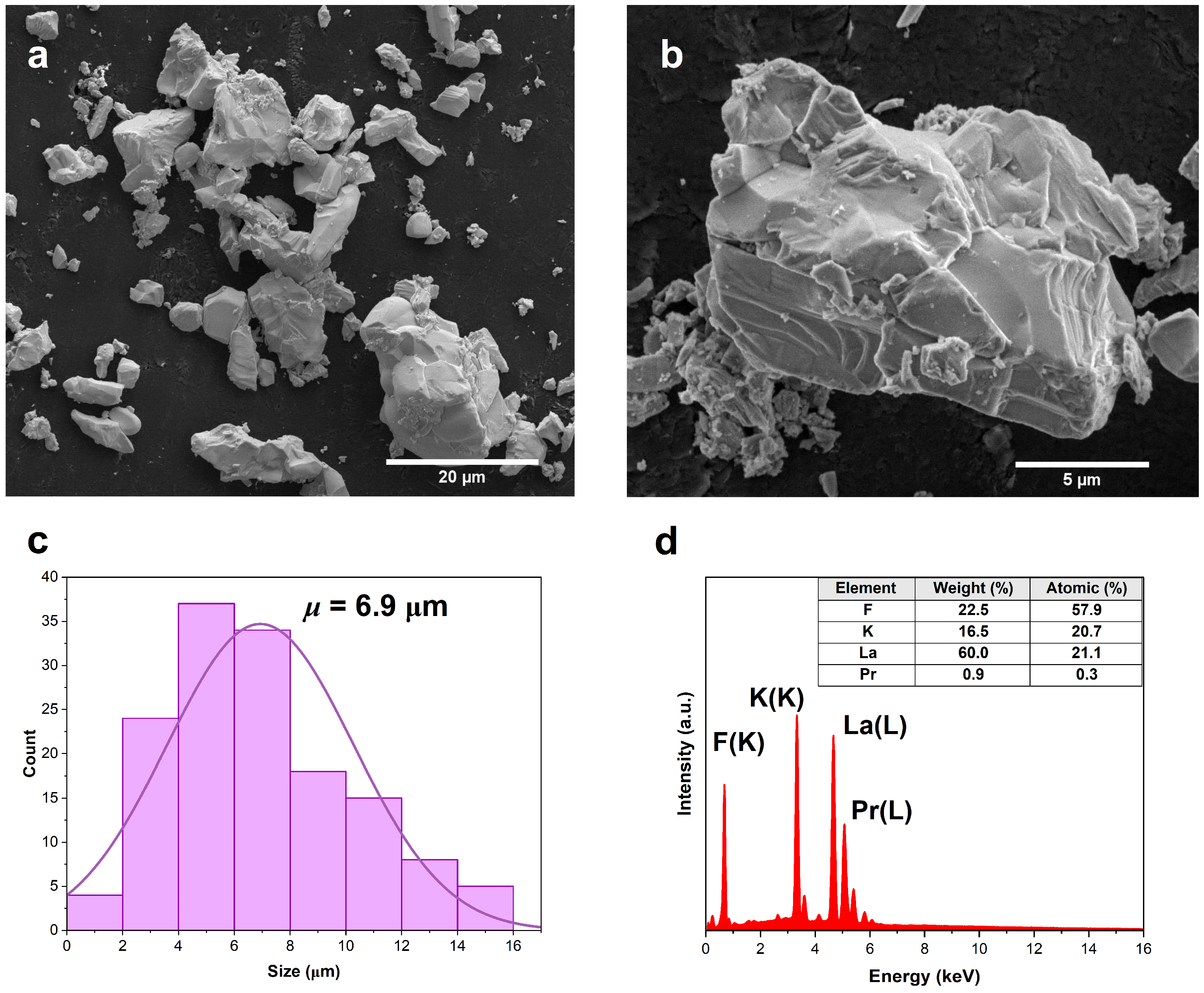



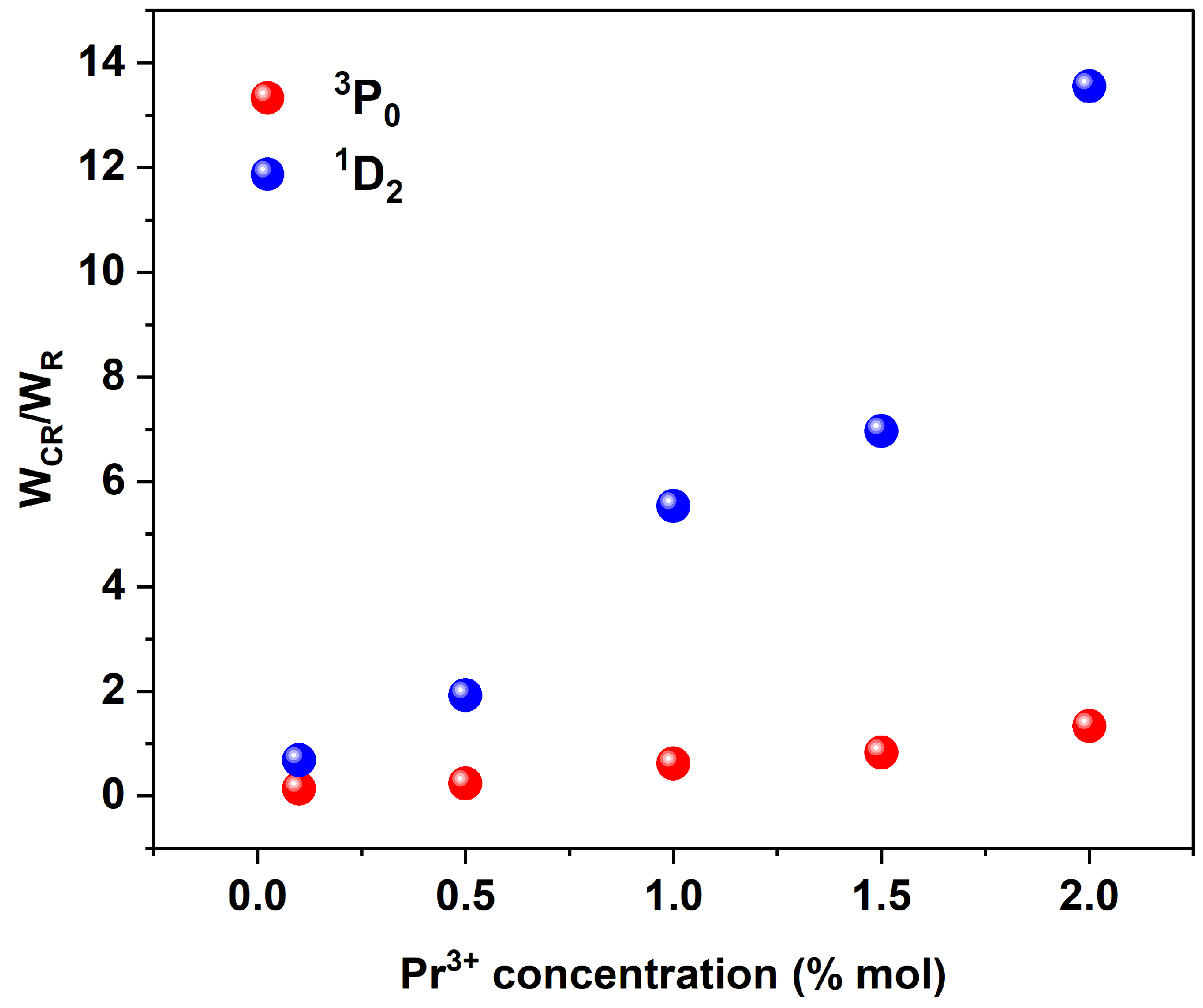
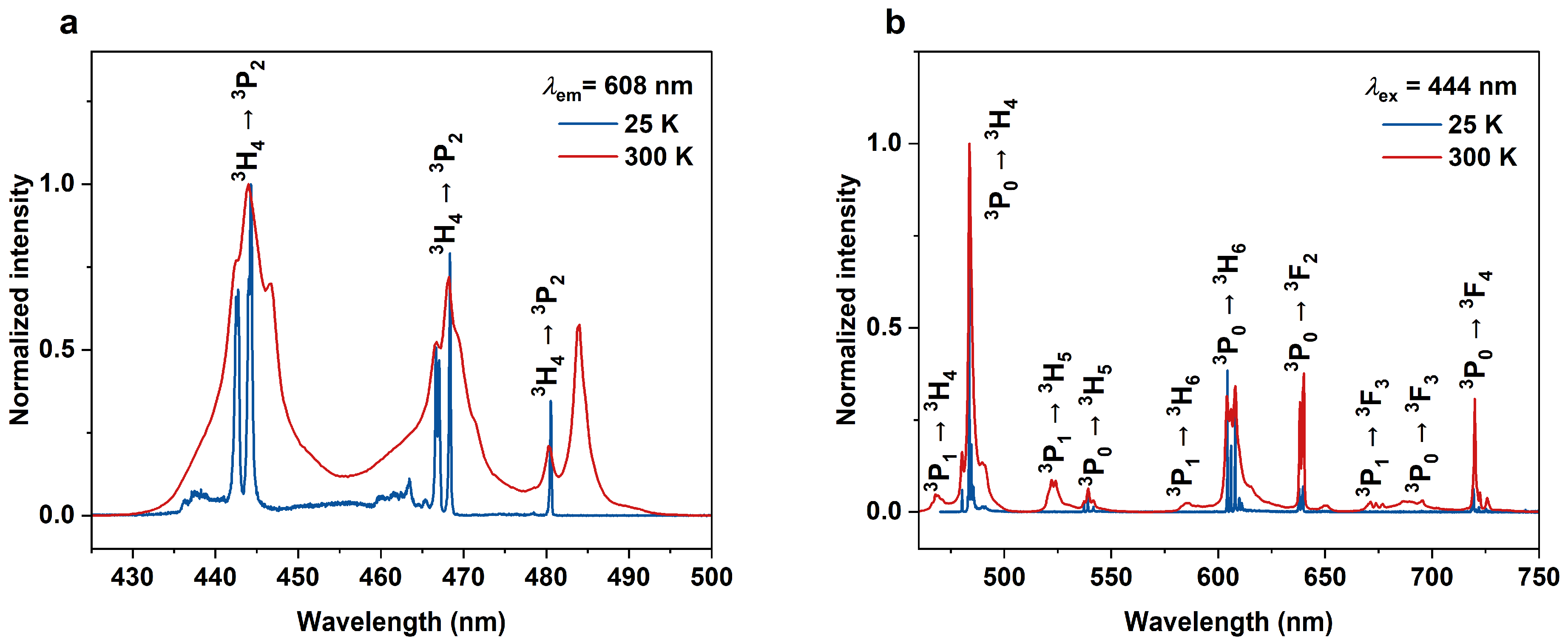
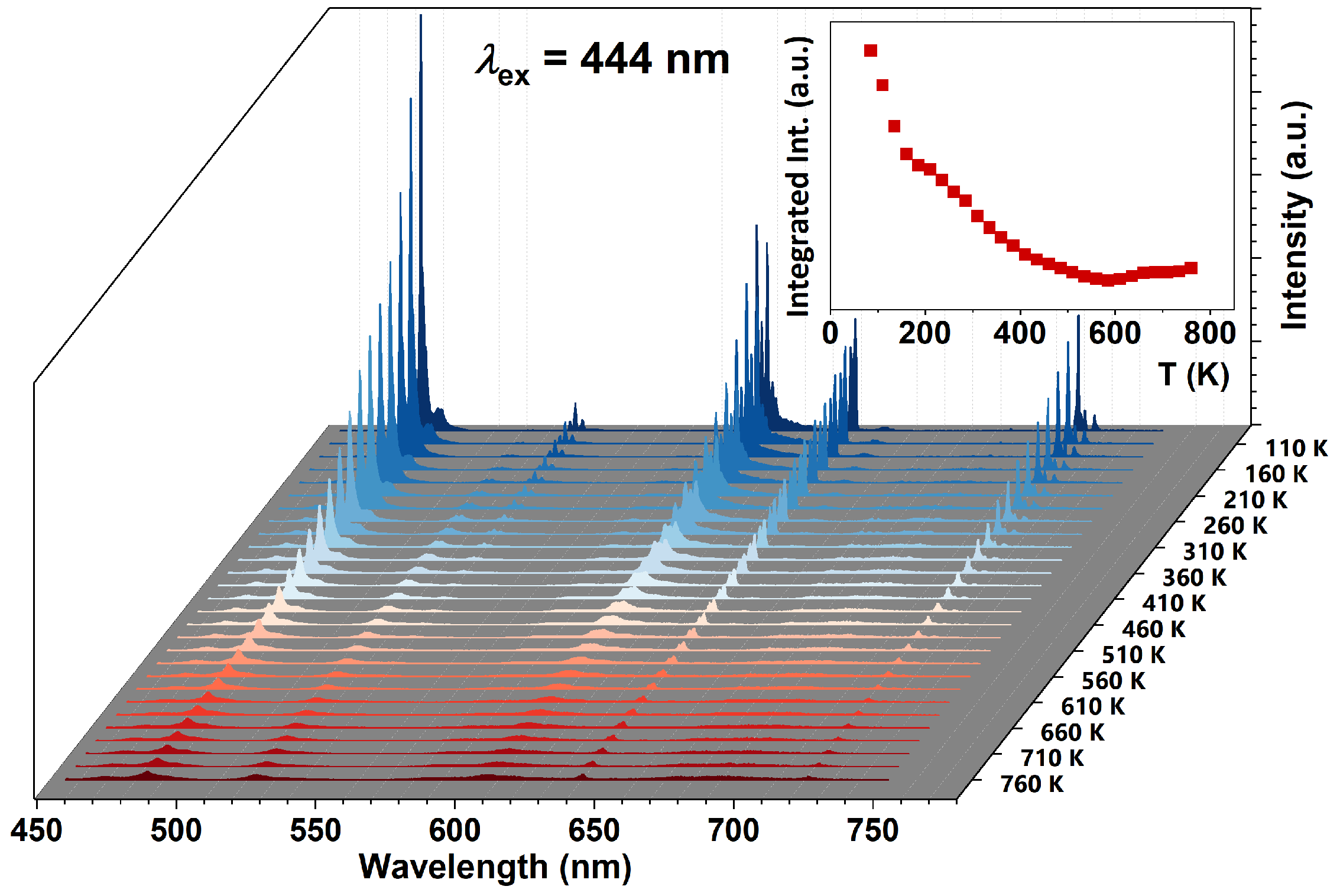
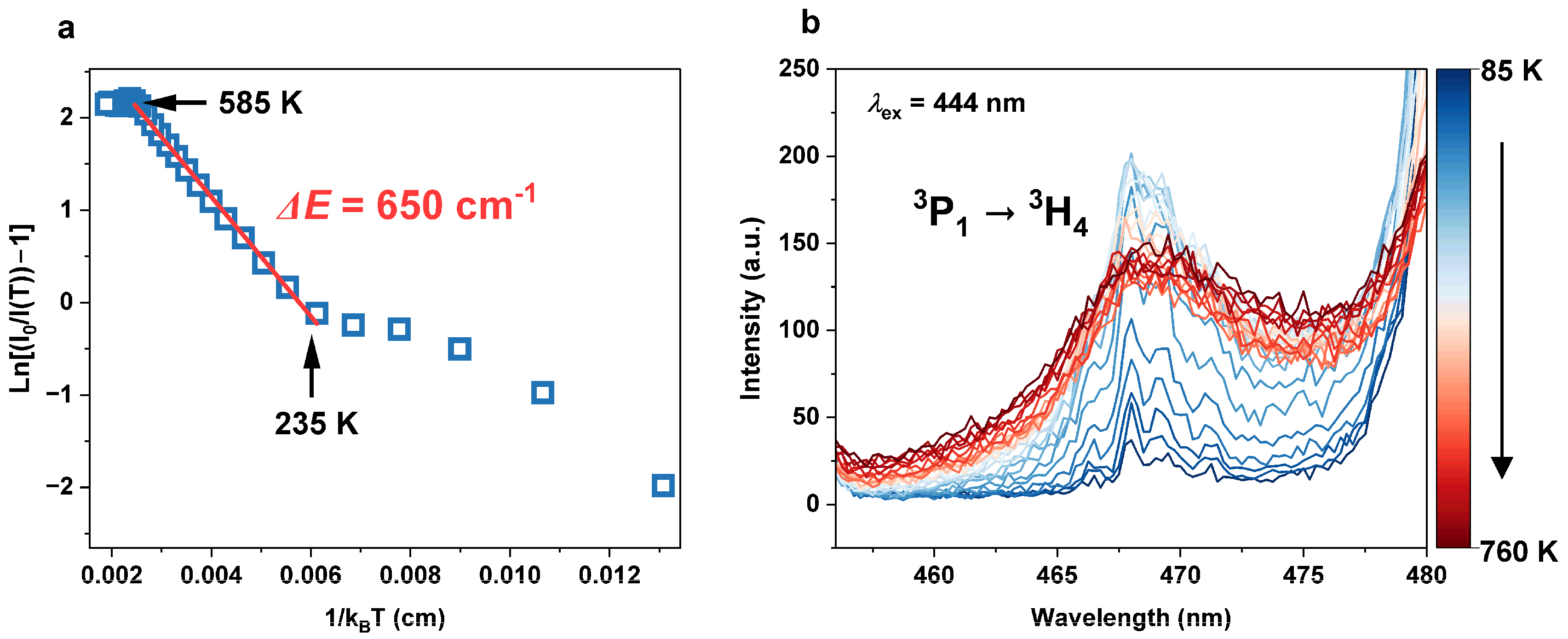
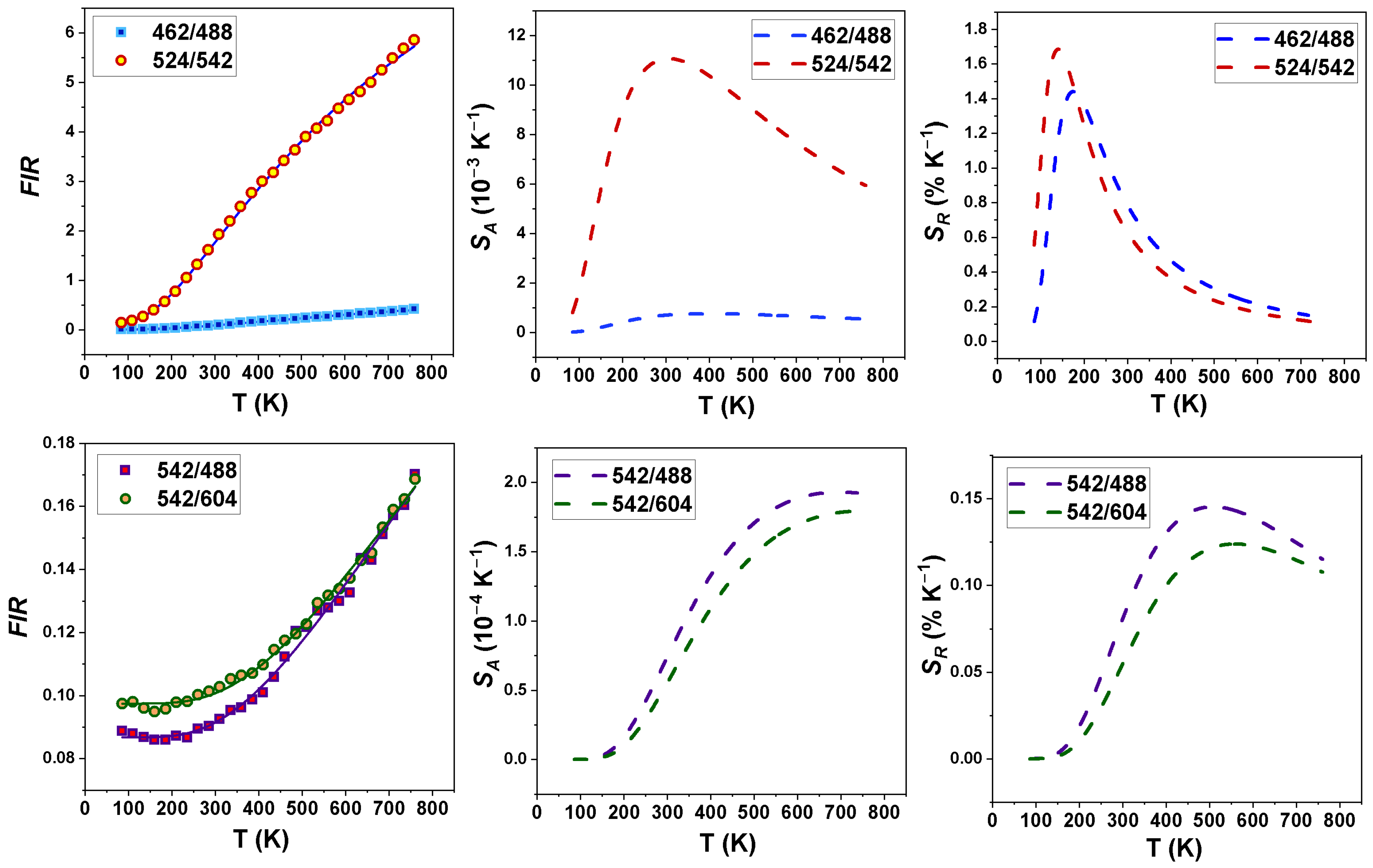
| Pr3+ Concentration (% mol) | 3P0 | 1D2 | ||||
|---|---|---|---|---|---|---|
| τR [μs] | τOB [μs] | WCR [s−1] | τR [μs] | τOB [μs] | WCR [s−1] | |
| 0.1 | 42 | 37 | 3.2 × 103 | 582 | 346 | 1.2 × 103 |
| 0.5 | 34 | 5.6 × 103 | 199 | 3.3 × 103 | ||
| 1.0 | 26 | 1.5 × 104 | 89 | 9.5 × 103 | ||
| 1.5 | 23 | 2.0 × 104 | 73 | 1.2 × 104 | ||
| 2.0 | 18 | 3.2 × 104 | 40 | 2.3 × 104 | ||
Disclaimer/Publisher’s Note: The statements, opinions and data contained in all publications are solely those of the individual author(s) and contributor(s) and not of MDPI and/or the editor(s). MDPI and/or the editor(s) disclaim responsibility for any injury to people or property resulting from any ideas, methods, instructions or products referred to in the content. |
© 2024 by the authors. Licensee MDPI, Basel, Switzerland. This article is an open access article distributed under the terms and conditions of the Creative Commons Attribution (CC BY) license (https://creativecommons.org/licenses/by/4.0/).
Share and Cite
Zdeb, P.; Rebrova, N.; Lisiecki, R.; Dereń, P.J. Luminescence Properties of an Orthorhombic KLaF4 Phosphor Doped with Pr3+ Ions under Vacuum Ultraviolet and Visible Excitation. Materials 2024, 17, 1410. https://doi.org/10.3390/ma17061410
Zdeb P, Rebrova N, Lisiecki R, Dereń PJ. Luminescence Properties of an Orthorhombic KLaF4 Phosphor Doped with Pr3+ Ions under Vacuum Ultraviolet and Visible Excitation. Materials. 2024; 17(6):1410. https://doi.org/10.3390/ma17061410
Chicago/Turabian StyleZdeb, Patrycja, Nadiia Rebrova, Radosław Lisiecki, and Przemysław Jacek Dereń. 2024. "Luminescence Properties of an Orthorhombic KLaF4 Phosphor Doped with Pr3+ Ions under Vacuum Ultraviolet and Visible Excitation" Materials 17, no. 6: 1410. https://doi.org/10.3390/ma17061410







